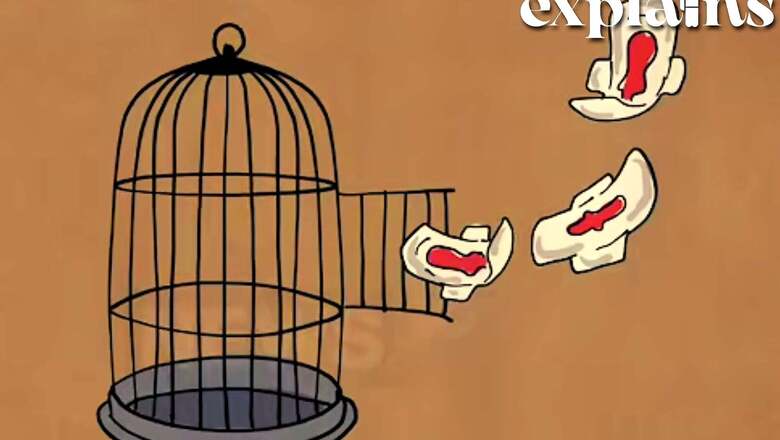
views
The Kerala government announced on Monday that it would grant menstrual leave to female students studying at all state universities under the Department of Higher Education.
Higher Education Minister R Bindu said the government has decided to implement menstrual leave in all state universities under the purview of the department, taking a cue from the Cochin University of Science and Technology (CUSAT).
“Taking into account the mental and physical difficulties experienced by female students during menstruation, necessary steps will be taken to implement menstrual leave in all universities,” she wrote on Facebook.
She praised Cochin University’s recent decision, saying it was the first time in Kerala that an educational institution had granted students menstrual leave.
What is the CUSAT Model?
CUSAT made the decision in response to a request from the university’s SFI-led students’ union. Given the students’ long-standing demand, the varsity sanctioned an additional 2% condonation of lack of attendance to female students in each semester on January 11.
CUSAT, an autonomous university, has over 8,000 students in various fields, with more than half of them being female.
“Having considered the requests for menstruation benefits to female students, the Vice-Chancellor has ordered to sanction an additional 2% of condonation of shortage of attendance to female students, in each semester, subject to reporting to the Academic Council,” according to a recent order issued by CUSAT’s joint registrar.
The order would apply to all female students at the university, including those pursuing PhDs, and is expected to take effect immediately.
Various students’ unions had submitted proposals seeking menstruation benefits for female students. Though their demand was to grant a fixed number of leave as ‘menstrual leave’ every semester, the authorities cited ‘practical difficulties’, said a report by the Times of India, and instead suggested the provision for condonation of shortage to female students, which was accepted by the unions.
What is Menstrual Leave?
Menstrual leave is a type of leave in which a person has the option of taking paid or unpaid leave/accounted for attendance from their job/academic institution if they are menstruating and unable to work as a result.
Period leave was first implemented decades ago in countries such as Russia and China with the goal of “protecting” fertility levels, Healthline reports.
If menstrual leave is thoughtfully implemented, it has the potential to improve the health and well-being of menstruators, particularly those with illnesses related to the menstrual cycle
There is now a growing movement to make it universal and normalise the effects that menstruation can have on a person, such as dysmenorrhea.
What is Dysmenorrhea?
Dysmenorrhea is the medical term for menstrual cramps or pain during one’s period. Dymenorrhea is classified into two types: primary and secondary.
Primary dysmenorrhea refers to menstrual cramps that occur repeatedly (recurrently) and are not caused by other diseases. Pain usually begins one or two days before the period or when the bleeding begins. One may experience mild to severe pain in the lower abdomen, back, or thighs, according to a report by Cleveland Clinic.

Pain can last anywhere from 12 to 72 hours, and one may also experience nausea and vomiting, fatigue, and even diarrhoea. Common menstrual cramps may become less painful as a person ages.
Secondary dysmenorrhea occurs when you have painful periods as a result of a disorder or infection in your female reproductive organs. Secondary dysmenorrhea pain usually starts earlier in the menstrual cycle and lasts longer than regular menstrual cramps. You rarely experience nausea, vomiting, fatigue, or diarrhoea.
What is the Debate Around Menstrual Leave?
There is concern that period leave policies may perpetuate the myth that women are incompetent and irrational when on their periods, which may have a negative impact on their career advancement, salary levels, and workplace relationships, the Healthline report states, adding that in Japan during the 1980s, people who took period leave faced discrimination and harassment from their employers.
Furthermore, according to a 2019 study, nearly half of participants believed that a period leave policy in the United States would only have negative consequences such as discrimination, with some respondents from the same study stating that menstruation isn’t debilitating for everyone.
“If menstrual leave is thoughtfully implemented, it has the potential to improve the health and well-being of menstruators, particularly those with illnesses related to the menstrual cycle,” Jessica Barnack-Tavlaris, Ph.D., associate professor of psychology at the College of New Jersey told Health Central.
And another pro commonly discussed is the fact that such a leave would held destigmatize the concept for many, especially in India, where periods and menstruation remains a taboo.
Menstrual leave could, in theory, help to normalise the conversation about periods. “I’d like to see the deconstruction of menstrual stigma become more mainstream,” Barnack-Tavlaris told Health Central.
According to a 2019 survey of US teenagers commissioned by period-proof underwear company Thinx and advocacy group PERIOD, 64% believe society teaches people to be ashamed of their periods, and 66% do not want to be at school while menstruating. Paid menstrual leave could serve as a good reminder to everyone that menstruation is nothing to be ashamed of, the report says.
India’s Menstruation Bill, 2017
A report by Live Law states that in order to provide menstruating individuals with favourable working conditions in India, Ninong Ering, an Arunachal Pradesh Member of Parliament, introduced the Menstruation Benefit Bill in 2017.
He introduced a private member’s bill that sparked debate in India about menstrual leave. However, the bill has not yet been passed, and India currently lacks a menstrual leave policy. No policy related to menstrual leave has been discussed in Parliament since the Menstruation Benefit Bill was introduced, the report claims.
The Menstruation Benefit Bill included some progressive measures to de-stigmatize menstruation and provide female employees with safe and healthy working conditions. It sought to level the playing field for all women by recognising their physiological needs.
The scheme’s highlights included providing women with a 4-day menstrual leave. The bill applies to all females in the private and public sectors, including students in grades nine and up. The first and second days of the menstrual cycle cause several discomforts for women, which have a significant impact on female employees’ productivity. Females who opt out of this benefit will be entitled to overtime pay at the rate in effect at the time.
Furthermore, the bill includes provisions for resting facilities at work during menstruation. Section 8 of the Bill states unequivocally that every woman has the right to self-perception of her menstruation in order to benefit from the Bill’s provisions. This provision leaves the door open for women to abuse menstrual leave. Furthermore, the Bill provides for penalties for employers who deny women access to benefits under the Bill. It also includes provisions for the formation of Grievance Redressal Committees to help women who are having difficulty obtaining menstrual leave, the report says.
With inputs from PTI
Read all the Latest Explainers here



















Comments
0 comment